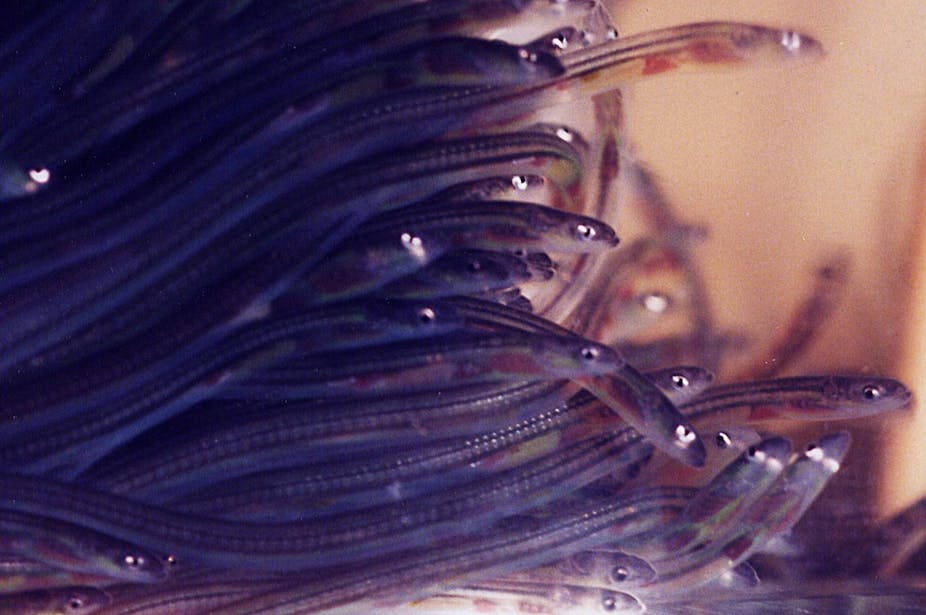Reports of the third successive year of rising eel catches in France suggests the eel’s drastic decline in numbers has finally bottomed out. However it’s important to note that today’s catches are a tiny fraction, barely 5%, of those made 30 years ago. Exactly what led to this decline is hard to pinpoint, but a recent study suggests that their extraordinary, ocean-going lifecycle may be one element.
Despite being well studied and considered by many as a delicacy, the European eel remains a most mysterious fish. Eels are inhabitants of European freshwaters and estuaries, but their journey starts more than 5,000km away off the east cost of North America, the waters of the Sargasso Sea.
After hatching in the Bermuda Triangle, a place of legends, larval eels passively drift on the trans-Atlantic Gulf Stream current. After several years adrift, they eventually reach the European coasts, whose rivers, lakes and estuaries will be their playground for several decades. Upon sexual maturation, adult eels return to the Atlantic again, swimming back to their spawning ground to reproduce and die.
After major yearly fluctuations observed in the 20th century, the number of young eels reaching the European coast collapsed in the 1980s, falling to 1% of average numbers in the past. The species is now considered critically endangered by the International Union for Conservation of Nature, the IUCN.
Published in the journal Current Biology, our research focused on addressing this population collapse, to try to understand how and why it occurred, and what the consequences might be. While these questions on the fate of the eels are still largely unanswered, the combined effort of biologists and oceanographers did discover a possible link between the fluctuations of young eels numbers reaching Europe (known as eel “recruitment”), and the variation of major ocean currents.

Under natural conditions, the abundance of eels that arrive in Europe depends on the variation of the North Atlantic currents. So the circulation of water in the eels’ spawning ground play a major role in the number of eels that successfully reach Europe. Using the latest oceanic model developed by GEOMAR and colleagues in Germany, we simulated oceanic currents observed during the 45-year period between 1960 and 2005. Seeding the model with eight million virtual eels, we compared their transatlantic progress predicted by our model with actual eel recruitment data collected since the 1960s.
Secrets of the Sargasso
What we discovered was that the model’s predictions of eels reaching Europe matched the real numbers observed over around 20 years. A specific ocean pathway connecting the Sargasso Sea and the Gulf Stream is of vital importance. Our simulations revealed that any disturbance here has a severe impact on the chances of eel larvae successfully arriving in Europe’s continental ecosystems. Interestingly, these connecting currents are weather/wind-driven. This observed link between difficult currents for eels in the Sargasso Sea seemed to match their decline starting in the 1980s, supporting one of the possible theories that the ocean itself contributed to lay behind the collapse of eel recruitment.

But after the collapse in stocks during the 1980s the model’s predictions fell out of step with recorded data. It’s possible that this synchronicity ended due to human pressures – overfishing, habitat destruction, barriers such as weirs and flood defences that prevent migration – or invasive parasites that infests the eel’s swim bladder and diseases. These pressures have potentially acted in concert with one another, preventing eel numbers from recovering naturally.
Eel’s bizarre biology
Famously, eels are considered to be panmictic, that is, their pattern of mating is completely random, without any structure. But some genetic studies have controversially argued against this. Examining the genetics of the eels, our study suggests that female eels may faithfully return to certain regions of the Sargasso Sea. This could be interpreted as an evolutionary response to the highly variable oceanic environments. Females would return to spawn in locations that have granted them survival through the transatlantic migrations as larvae, to ensure the same success to their offspring. Males on the other hand would show no such interest in particular areas, and roam between female spawning sites.
Our findings also raise awareness of re-stocking strategies, where freshwater streams and rivers with depleted or missing eel populations are re-populated with young eels captured where they are abundant. Interestingly a recent study has shown that eels moved in this way still maintain their bearings and migrate in the right direction. Further studies now have to focus on showing that ultimately the fitness of these eels and how well they succeed is also unchanged.
In a world increasingly shaped by fast-developing human activities. it is essential to understand species’ evolutionary background and use this to develop suitable conservation measures. Eels are no exception, and the question of how human activities affect the waterways that are so vital to this fascinating species require us to look more closely at eel genetics. The eel genome contains the pages of the book of the species’ evolution and, ultimately, the key to its conservation and future.

